I love street photography. I love the energy of it. I love the unplanned immediacy of street photography. I love the connection between the photographer and what’s taking place within the frame, and I love the connection between the viewer and the image itself. When you look at a good street photo, the photographer disappears — it feels as if it’s just you and what’s happening in the photo, unfiltered by any photographer. I love street photography.
Wait, let me amend that — I love street photography when it’s done well. But here are a couple of true things: first, it’s really difficult to do it well. And second, it’s even more difficult to do it well with consistency. Good street photography is hard. Bad street photography, on the other hand, is incredibly easy.
I should also point out that although I love street photography, I’m not a street photographer. I sometimes shoot photographs on the street (though I’m more likely to shoot in alleys), but street photography isn’t entirely about location. It’s about the ways people inhabit and move through public spaces. Most of the photographs I shoot in public spaces are urban landscapes. If there are people in the photographs, they’re incidental.
That said, I often see good street photographic moments when I’m out noodling around. I’m a completely fucking brilliant mental street photographer. But brilliant mental street photography doesn’t translate to the camera. It’s one thing to see a street moment and think ‘There — that’s it.’ It’s entirely another thing to anticipate that moment, put yourself in the right spot, and have your camera ready to shoot it. That’s one of the reasons I’m not a street photographer. I’m just not willing to walk around with a camera always at hand, ready to snatch that exact moment when everything comes into alignment.
But last week, as I was wandering around downtown, it occurred to me that I do always have a camera at hand. My smartphone. It’s not a great camera, but so what? It’s quiet and unobtrusive, which is pretty important for street work. I have an app called Lenka that shoots basic black-and-white images. This clearly isn’t the optimal arrangement for street photography, but it’s what I had with me. You have to work within your limitations.
I set the app to allow me to take a photo by pressing the volume button on my phone (so I wouldn’t have to fuss about with using the phone as a viewfinder) and went off try some street. Almost immediately, I came across a small group of folks learning to be blind. The headquarters of the National Federation of the Blind is located downtown, and I assume that’s why we so often see a group of blindfolded people with canes being escorted around town. I took a couple of shots without looking.
They weren’t great photos, but they were enough to encourage me to keep trying. I wandered around, saw some interesting folks, took some shots. I tried not to focus too much on people who looked interesting, because those were mostly folks who were marginalized because of addiction or abuse or weight or some other social condition. I tried to look for visually interesting situations instead.
Then I ran into this old drunk guy.
He immediately panhandled me, asking for spare change. I don’t carry much money; I use a debit card for everything. The only cash I had was a couple of twenties. So I told him I didn’t have any change — and I surreptitiously took his photo without looking. Shameful behavior on my part. Doubly shameful in that the photo was blurry.
The guy grinned and offered to take a twenty, which was a nice move on his part. It made me like him enough that I wanted to give him something. I told him I was heading for the drug store across the street and down the block, but if he was around when I came back that way, I’d hand over a little something — and I surreptitiously took his photo again. Still without looking; still shameful. This time the photo was badly exposed.
So I went to the drug store, bought a cupcake for myself and a chicken salad sandwich for the old drunk guy. When I came out of the store, the ODG was hobbling across the street with his walker. I’d told him I was going to give him something and dammit, he was going to make sure I didn’t forget. I gave him the sandwich and a couple of bucks (and yes, I knew he’d spend the money on booze). Again, I surreptitiously took his photo. Again, it didn’t turn out well; badly expose and blurry.
That’s what you get for shooting without looking, I suppose.
Having done my part to support the local alcoholic community, I kept on wandering and shooting. Every so often I’d stop and find a place to sit and chimp the photos. Most of them were bad. Some were really bad. But mostly I was okay with them. If nothing else, I was learning to get the framing right. Mostly. Partly. That’s hard to do when you’re shooting from the hip.
The light was getting increasingly harsh, the shadows were radical — great conditions for urban landscape photos, but not what you’d call street-friendly if you’re relying on shooting blind with a smartphone. Almost everything I shot was badly (or weirdly) exposed.
I decided to end the experiment. I knew a nice, quiet, dark space nearby (okay, let’s just call it a tavern), so I headed there for a cool drink and a chance to evaluate the photos. On the way there I came across the old drunk guy again. He’d taken off his shoes, put them in the basket of his walker (along with the uneaten chicken salad sandwich), and laid himself out on a public bench for a nap. Or to sleep it off.
And hey, I took his photograph one more time. Shameless again.
I learned four things from the experiment. First, I’m not a good street photographer. I’m okay with that. I’m not a rotten street photographer either. I can improve. If I decide to. Second, street work has a moral component. In the U.S. you pretty much have the right to photograph anything and anybody in the public arena. Doesn’t mean you should, though. Third, if you have a moral discussion with yourself before you shoot a photo, you’ll probably lose the shot.
Earlier I mentioned I tried not to focus too much on people who only looked interesting, because they tended to be folks who were marginalized in some way. Shooting photos of those folks would (or easily could) be exploitative — even if that wasn’t my intent, and even if I never showed the images to anybody. It would, in effect, be turning them into props; it would not be treating them as people.
There was a specific moment during the day I made a rule for myself. Shoot first, decide later if the photograph was ethical. Here’s how I came by that rule. I saw another drunk guy. The old man I’d met earlier was clearly an alcoholic, but he seemed pretty self-aware of his condition. He was friendly, with a sort of style and charm about him. He was clearly intoxicated, but not sloppy drunk. He was a sad case, but he was in control of himself and I liked him.
The other drunk guy was probably in his late 20s. He was staggering drunk. Oblivious to the world drunk. Slobbering and probably in dubious control of his bladder drunk. High school drunk. There was nothing likable or charming or self-aware about him. I could feel compassion for him and his situation, but I still recognized he was pretty disgusting. And he was heading up the sidewalk toward the public library.
I hurried to catch up. I didn’t feel any need or desire to photograph the guy himself, but I thought it might be interesting to photograph the reactions of the people he met in the library. I took a single shot when a library patron came out of the library as the drunk guy approached. And then I thought it would be cruel to photograph those reactions; it would be demeaning to the drunk guy himself, and to the people he encountered. The photos wouldn’t be about anything but condemnation for a man who had some serious problems.
So I turned off my phone and put it in my pocket. I felt I’d made the right decision when, as these two guys approached each other, the library patron looked completely repelled. But as they got closer the library guy’s face shifted from loathing to concern. He stopped and spoke to the drunk guy; I couldn’t hear, but I assume he was asking if the drunk guy was okay. The drunk guy just lifted a hand — maybe in acknowledgement, maybe in denial, maybe a suggestion that the library guy should mind his own business, I don’t know — and he just kept zombie-shuffling toward the library.
I’d turned my camera off. I missed that shot. It had the potential to be a truly good street photo. It was a strangely non-judgmental moment. Almost sweet, on the part of the library patron. And that’s then I decided shoot first; decide its value later.
I said I learned four things from the experiment. Here’s the fourth: a sincere attempt at street photography (for me, at any rate) is oddly dissociative. It’s a combination of being very aware of yourself and the world around you, yet being somewhat removed from it. Until — and this is the freaky part — until you see the elements of a photo possibly coming together. At that point you become intensely aware. Of everything. The light, the geometry of the background, the spatial relationships of what’s in the frame, and you start plotting vectors of interception — where it’s all going to come together and where you need to be at that point to shoot the photograph. And it’s both exciting and terribly frustrating because oftentimes you’re also hyper-aware that you’re almost certainly NOT going to be in the right spot at the right moment and you’re going to miss the shot.
I love street photography — when it’s done well. I doubt I’ll ever be terribly good at it, but I’ll periodically continue the experiment. If nothing else, it’s great fun.

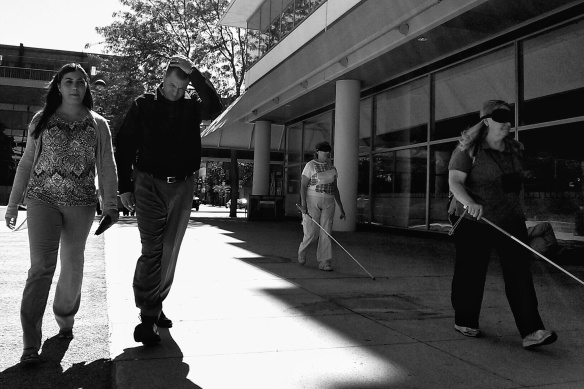
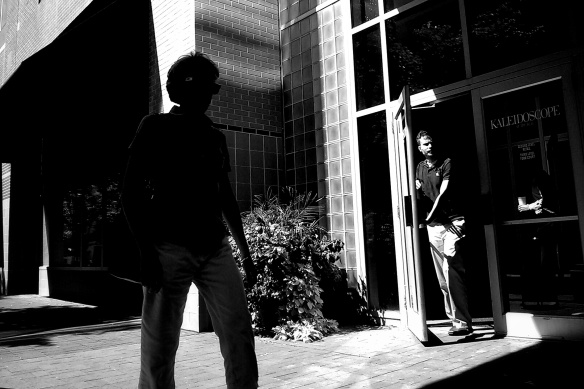

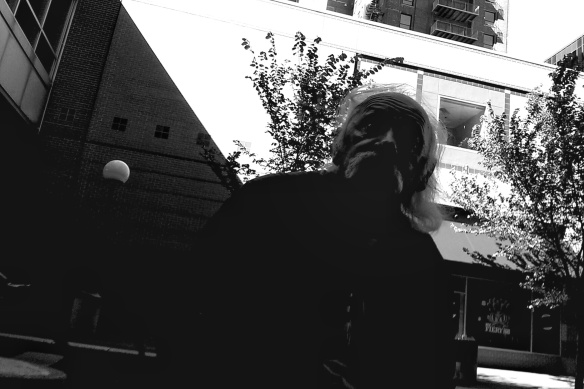

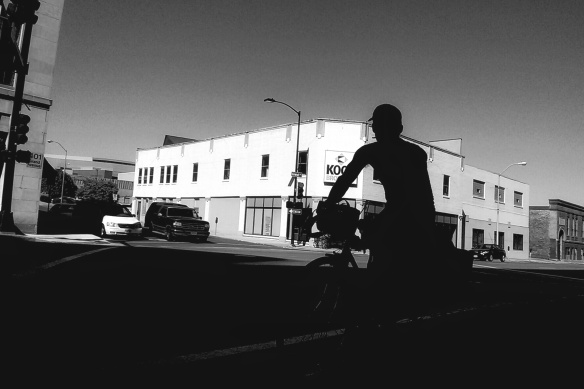
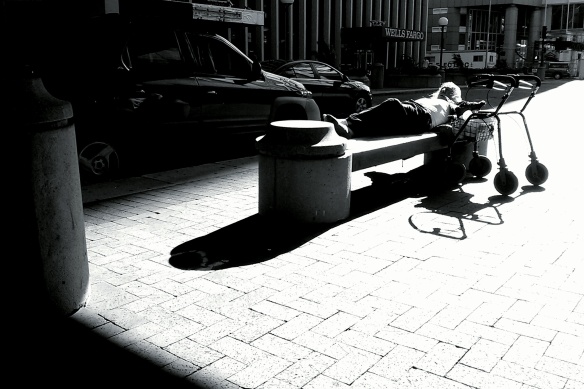
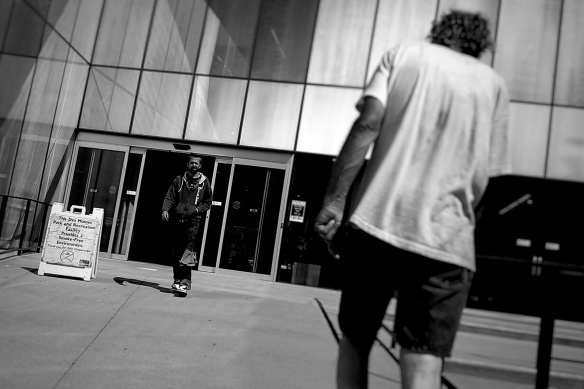
I’m also not very good at it… I’m a little better with those I shoot with the mobile, because I can use it a little more surreptitiously, than I am with my Rolleis. I am the slowest focuser in the world and I’m terrible at zone focusing.
LikeLiked by 1 person
I should try a few rolls employing the “F8 and don’t be late” technique.
LikeLike
I may consider buying a new phone — one with a decent camera. I was surprised at how different it felt to shoot with total anonymity. There were photos I never would have shot with a real camera — even my small Fuji X10. Of course, they didn’t turn out terribly well because I was shooting blind, but I think with some practice I’d get better at having some idea what’s in the frame.
That said, if I was actually serious about shooting street, I’d learn to get over my desire to be completely inconspicuous.
LikeLike
I want a phone with a swiveling camera… that would really make surreptitious shooting easier.
LikeLike
Word is there are a few street photo blogs on WP. I’m sure you’ve seen a few.
I’ve heard it said, “it’s better to ask forgiveness than to ask permission” or some such.
LikeLiked by 1 person
Yeah, there’s great street work all over the InterTubes. Part of my problem, I think, is that I spent a few years professionally invading the privacy of strangers — so I’m doubly reluctant to do it now. That doesn’t make any sense, of course, But there it is.
LikeLiked by 1 person
I really like the bicyclist photo. The silhouette with the sharp, bright building in the background is a great contrast. I also like the blurry drunk old guy sitting on the bench. It’s quite apt.
LikeLike
The old guy was great. Sad, but great. Funny, cheerful…but embarrassingly desperate even for the couple of bucks I gave him. That stretch of street is often occupied by panhandlers, so there’s a good chance I’ll see him again. I’ll let him get to know my face (if he’s capable of remembering faces) and I’ll chat with him a bit each time I see him, and maybe I’ll learn something of his story.
LikeLike
Shooting street for me is both hard and addicting. Hard in what you pointed out about the difficulties of being at the right time, at the right place, with everything perfectly set to get the right exposure, focus, etc.. Addicting because, to me, shooting street is like improv in music. You have a general idea of where you want to go, but absolutely no idea how you’re going to get there. You have to wing it, and I love winging it.
One thing I will say though, your experience sounds like most experiences I have when I go out to shoot in that, technically, I find myself making tons of bad shots and only come away with a couple of keepers. Yeah, practice helps, but you’ll still blow shots left, right, and center.
As for the moral thing, you hit the nail on the head in terms of shoot and wrangle with the moral question later. On deciding whether or not to “publish” (i.e. social media, etc.) an image, I usually use a simple test when looking at the story. Is there more than one moral interpretation to what I’m looking at? If so, I’ve got no problem putting it out there. If what I’m looking suggests something genuinely exploitive of someone’s situation, I’ll think long and hard about posting it.
Still, when it comes to shooting the marginalized, I tend to err on the side of relevance given what’s going on. The other day, I shot a guy who was hammered out of his mind and looking about as transient as you can get around here. I shot him not because I thought it was emblematic of the sad state of affairs of both himself and society as a whole, but more so because he asked me whether or not the chess game he was playing was in checkmate. This led to a conversation which led to him whipping out a harmonica and riffing on a tune he thought up on the spot. In that moment, he was no longer marginal, no longer drunk. He was in a zone. I didn’t ask him to play. He just did, and I shot, and I think I managed to get a couple of images that, in my opinion, killed the stereotype. Now, I didn’t by him a chicken salad sandwich, but I did make a couple of prints, track him down, and give them to him. I got a hug in return.
Keep it up tough. Keep looking for those moments, ’cause when you do get them, it’s a high like no other.
LikeLiked by 1 person
Pete, I’ve never seen you put this many words together in one place before. You should do it more often.
I don’t think there’s any single moral/ethical metric we can reasonably apply to whether it’s ‘appropriate’ to shoot or publish any particular street photo. Certainly the photographer’s intent matters — but mostly to the photographer. Intent doesn’t translate to the image itself. Maybe it’s enough that the photographer HAS some sort of ethical metric and applies it, whatever it is.
(By the way, this was written by Pete Rosos, who is a kick-ass photographer. Some of his work can be seen at http://2812photography.com)
LikeLiked by 1 person
I really enjoyed reading this, especially the part about the old guy. A visual treat as well :)
LikeLiked by 1 person
Thank you. I liked the old guy. I felt sad for him, but I liked the way he didn’t seem to feel sorry for himself — or expect me to feel sorry for him either.
LikeLiked by 1 person
Everything you said resonated – from the “I’m a completely fucking brilliant mental street photographer” to the “and yes, I knew he’d spend the money on booze” to the whole moral conflict and dissection. And then went and you threw in cupcakes for the superfecta.
Love the framing in that library photo and the bike shot rocks.
LikeLiked by 1 person
Katya, I suspect this is something you and I have in common. We walk around and we see these perfect photographic moments — a bird dropping off a limb, a person who reaches for a door handle with a wrist bent like a dancer, the intersection of the shadows of a bench and a pedestrian — just a fraction of a moment, and even though no photograph is actually taken, that transient image will spark a smile that’ll last all day.
LikeLike
*And then you went and threw in…
LikeLike